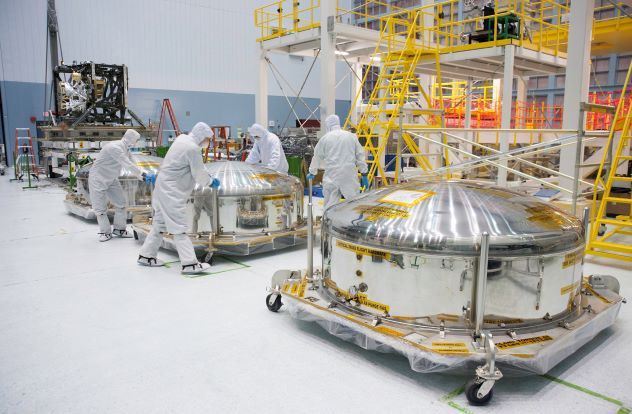When we think of cleanrooms, we usually think of manufacturing, technology, food processing, research, etc. But have you considered how those processes are used by NASA for space exploration?
That’s right! NASA uses cleanrooms – and quite often, too! Not only is their equipment highly tuned, so it needs to be manufactured in a clean room, but they have an obligation to keep space clean and study a lot of different space materials.
So how exactly does NASA use cleanrooms?
1. To Evaluate Space Materials
When NASA brings back materials from space – such as the Apollo rocks – they store them in cleanrooms to be studied at a later date. These cleanrooms keep them free from Earth’s contamination, so when we study them, we know what we’re seeing is not from Earth.
In 2018, an ISO class 6 cleanroom in Houston, Texas, where NASA was storing extraterrestrial rocks, was found to be contaminated with fungi. These rocks were kept in cabinets where nitrogen was being pumped into them at above-atmospheric pressures. The air filter was installed in 1979 and not checked for over 40 years. So when they started looking for fungi, they found a much higher amount near the fan.
After this discovery, other NASA researchers began to question their own work. Had their findings actually been extraterrestrial, or was there Earthly interference? It’s impossible to tell now. But what NASA can do is make sure their cleanrooms are well-maintained to avoid future contamination.
NASA classifies its missions from Category I to Category V in its Planetary Protection program depending on how high the contamination risk is to Earth. Category I missions pose little contamination risks, but Category V poses an increased risk.
The Mars 2020 rover launch was considered a Category V mission because they are collecting samples with the intention to return them. Thus, this mission was held to very high standards in terms of how much the rover is allowed to collect and how it should be handled upon return to Earth.
If we truly want to know what’s happening on other planets, NASA’s cleanrooms are the place to do it, so long as they truly stay clean!
2. To Assemble Spacecrafts
NASA does not just use cleanrooms to conduct research. They also use cleanrooms to assemble and build their spacecraft!
We know that cleanrooms are commonly used to produce technological components, such as semiconductors. So it makes sense that NASA would use cleanrooms to assemble their highly technical and intricate spacecraft – and all the computers inside them.
Not only are the instruments onboard a shuttle or satellite sensitive to dust, but they can also be hurt by humidity. In a cleanroom setting, we can control the humidity, temperature, and particle exposure.
But NASA doesn’t just keep their space crafts clean for the sake of the instruments. They keep it clean for space’s sake, too!

Photo Credit: NASA Desiree Stover
3. To Clean Space Crafts Before Going Into Space

Photo Credit: James Space Webb Space Telescope
In 1967, The Outer Space Treaty was signed by the United States of America, the United Kingdom, and the Russian Federation. According to the United Nations Office for Outer Space Affairs, the treaty says:
- “The exploration and use of outer space shall be carried out for the benefit and in the interests of all countries and shall be the province of all mankind;
- outer space shall be free for exploration and use by all States;
- outer space is not subject to national appropriation by claim of sovereignty, by means of use or occupation, or by any other means;
- States shall not place nuclear weapons or other weapons of mass destruction in orbit or on celestial bodies or station them in outer space in any other manner;
- the Moon and other celestial bodies shall be used exclusively for peaceful purposes;
- astronauts shall be regarded as the envoys of mankind;
- States shall be responsible for national space activities whether carried out by governmental or non-governmental entities;
- States shall be liable for damage caused by their space objects; and
- States shall avoid harmful contamination of space and celestial bodies.”
That last line is the most important in this context! Any country that visits space has an obligation to keep it clean. We keep Earth on Earth and space in space to create as little disruption as possible.
So not only are spacecraft assembled in cleanrooms for technical purposes but they are also cleaned in cleanrooms before going into space.
To test the effectiveness of the cleaning, they use Q-tips to swab the spacecraft and test them to see how many microbes survived. The 70% isopropyl alcohol cleaning won’t kill some microbes, but the experts know what will be killed by the vacuum of space and what needs to be taken care of on Earth.
All About Keeping It Clean!
From start to finish, NASA makes good use of cleanrooms. They build spacecraft components, assemble them, clean them, and receive their samples all in a cleanroom. Without this technology, we would not be able to explore and understand space like we currently do.
Although we still have more than we know to explore and learn!
If you want to learn more about how we use cleanrooms on Earth and beyond, check out our Knowledge Center. You can create a free account to have unlimited access to our information on cleanrooms, particle counters, and industry standards and trends!
To know more, please check Lighthouse.

